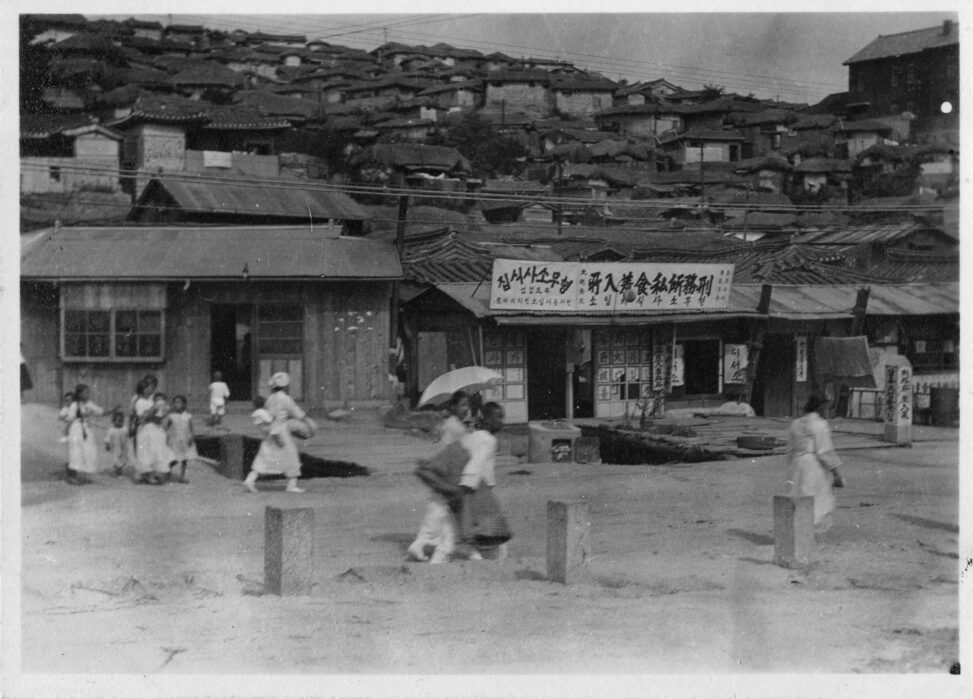During the 1930s, Korea was occupied by Japan after first being annexed in 1910. Japan invaded Manchuria during this time period and consequently began to further drive industrialization in Korea as it served as the base of their military expansion operations (Hwang, 2022). The image I have chosen to analyze for this paper is set in this same time period and was photographed by Albert E. Kane. The original title of this photo was “Keijo, Korean Village,” and it depicts what appears to be a residential area in Seoul (also known as Gyeongseong or Keijo under Japanese rule) during an estimated time frame of 1932 to 1937. This image is a deviation from the most common photographic representations of Seoul during the 1930s which often portray Seoul’s sprawling cityscape made up of western-style brick buildings. The landscape portrayed in Kane’s picture show’s little signs of the industrialization and urbanization that was taking place in Seoul during this time. Instead, it offers a quaint image of village life in Seoul with its depiction of children and young women passing by small shops on a road yet to be paved.
Based on the shape of the roofs and architecture of the buildings in the photo, this area seems to be a hanok village which would confirm that this location is a residential area. A hanok is a traditional Korean house that dates back to Korea’s Joseon Dynasty; the architectural style of these homes are thousands of years old (Lee et al., 2021). As a result of urbanization and development, many hanoks have been destroyed which prompted the Seoul Metropolitan Government to initiate projects to preserve and revitalize hanoks during the 1990s, specifically in the Bukchon district of Seoul (Seoul Metropolitan Government). Hanoks have become a popular tourist attraction in contemporary times; some of the most well-known villages in South Korea are Jeonju Hanok Village and Bukchon Hanok Village (Lee et al., 2021). It is possible that the area pictured may have already been demolished and redeveloped in modern times, but considering the South Korean government’s designation of hanok villages as cultural heritage sites, it is also possible that the village in the picture may have been preserved to some extent.
Another part of the image that stands out is the signage on the building in front of the village. On the left side, the hangul indicates that the building may be a restaurant with the Korean word for “meal” clearly written. The characters on the right half of the sign are most likely Japanese kanji, considering that Korea was still under Japanese rule during the time frame this photo was captured; the restaurant may have wanted to appear accessible to Japanese customers. During this time period, there were hundreds of thousands of Japanese settlers on Korean soil. In 1930, a third of Seoul residents were Japanese (Eo, 2022). Koreans were also required to adhere to regulations enforced by the Japanese colonizers such as writing publications in Japanese, and colonial officials went as far as shutting down Korean-language publications towards the end of the 1930s (Hwang, 2022). The influence of Japanese occupation can be seen in this photo through this sign.
Considering the huge metropolis that Seoul has developed into today, it is interesting to consider that it grew from the humble village pictured in Kane’s image. By 1940, Seoul’s population was 930,000, growing exponentially from 240,000 in 1920 (Eo, 2022). According to data from the United Nations, Seoul’s population in 2021 was close to 10 million. Although it nowhere close to the size it is now, Seoul during the 1930s was still a flourishing urban center. Kane’s purpose in taking this picture might have been to capture a quieter side of Seoul, away from the bustle of city life. For the women and children we see in the picture, this scene might be what an average day looks like for them; they could be on the path to work or school or on the way home. This image shows little influence from any outside cultures besides the Japanese sign which also may have been the photographer’s intention. Typical representations of Seoul during the 1930s emphasize the scale of the city and the western architecture, but this image portrays Seoul as a village with the traditionally Korean architecture of the hanok houses. Overall, it’s a simplistic depiction of Seoul; a far cry from the complex and massive city it is now.
Works Cited
Eo, K. (2022, October). The “Modern Girl” Problem. Course: Introduction to Korean Civilization. Boulder; University of Colorado, Boulder.
Hwang, K. M. (2022). A History of Korea (3rd ed.). Bloomsbury Academic.
Lee, C.-K., Reisinger, Y., Ahmad, M. S., Park, Y.-N., & Kang, C.-W. (2021). The influence of Hanok experience on tourists’ attitude and behavioral intention: An interplay between experiences and a value-attitude-behavior model. Journal of Vacation Marketing, 27(4), 449–465. https://doi.org/10.1177/13567667211011761
Seoul Metropolitan Government. (n.d.). Hanok Village. Seoul Hanok. Retrieved May 1, 2023, from https://hanok.seoul.go.kr/front/eng/town/town01.do
